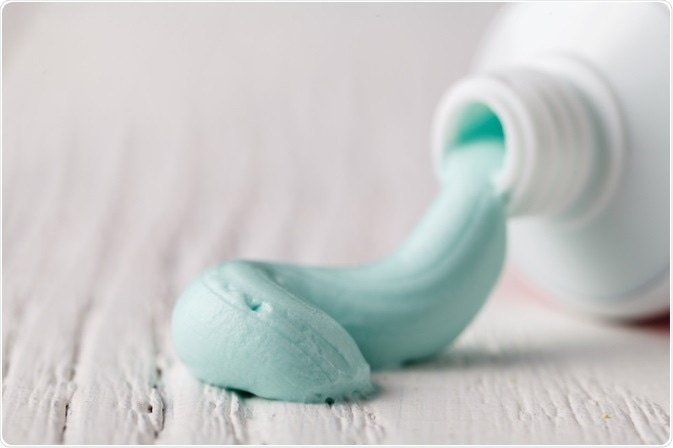Introduction
How was toothpaste made in the past?
What are the constituents of toothpaste?
Are any of these ingredients toxic?
What ingredients should be avoided in home-made (natural) toothpaste?
Which ingredients should you include in home-made toothpaste?
How to make toothpaste at home
References
Further reading
Toothpaste has various uses, such as freshening the breath, helping to prevent oral problems including halitosis, whitening the teeth, and helping with overall teeth cleanliness. Moreover, it can be easily made at home using basic ingredients and a simple procedure.
 Image Credit: Tasha Cherkasova/Shutterstock
Image Credit: Tasha Cherkasova/Shutterstock
How was toothpaste made in the past?
According to ancient records, the first toothpaste was made by the ancient Egyptians (c. 3,000‑5,000 BC), using the ashes from burnt oxen hooves or egg shells. The ashes were converted into powdered form and then combined with pumice.
This combination was primarily meant to remove the accumulated debris from the surface of the teeth. It is believed that water was added to this mixture to form a paste before use.
What are the constituents of toothpaste?
Currently, toothpaste serves two basic functions - therapeutic and preventive. In general, American Dental Association-approved toothpaste contains fluoride and other active ingredients which serve specific functions such as tooth whitening, plaque removal, minimizing gingivitis, and preventing halitosis (bad breath) and tooth erosion.
Active ingredients that are typically found within approved toothpaste brands include:
- Anti-caries agents (e.g. fluoride) which enhances the dental remineralization process and helps repair early tooth decay,
- Antihypersensitivity agents - including potassium salts, stannous fluoride, amorphous calcium phosphate, casein phosphopeptide, and calcium sodium phosphosilicate - which help to minimize tooth sensitivity,
- Antimicrobial agents such as stannous fluoride, triclosan, and zinc citrate, which help to prevent the accumulation of plaque.
Other ingredients include:
- Abrasive agents such as silica abrasives or enzymes to remove built-up stains on the teeth
- Detergents like sodium lauryl sulfate and sodium N-lauryl sarcosinate which help to produce better foam, and which have a cleansing action on plaque and other oral debris
- Flavoring agents, particularly sugar-free substances like saccharin, to make the toothpaste palatable or even attractive to the user
- Humectants like glycerol to protect the toothpaste against water loss
- Binding agents like mineral colloids, natural gums, seaweed colloids or synthetic cellulose to give it body and so stretch out the toothpaste for a longer period
- Peroxides like hydrogen and carbamide peroxides to prevent tooth stains from lingering
Are any of these ingredients toxic?
Though conventional toothpaste is usually safe for use, an overdose of some of these ingredients could be fatal. Toxic ingredients in toothpaste could include sodium fluoride and triclosan. An overdose may result in stomach pain or an intestinal blockage. Immediate medical attention should be sought if an overdose of conventional toothpaste is suspected.
What ingredients should be avoided in home-made (natural) toothpaste?
Given the above potential for toxicity, many consumers are turning to natural toothpaste. Natural toothpaste prepared at home is free of any side effects but delivers both preventive and therapeutic benefits to help maintain good oral health.
When making your own toothpaste at home, the following ingredients are best avoided, primarily due to their side effects:
- Glycerin - though safe for use, it is believed that it forms a thin layer on the surface of enamel which may prevent the process of remineralization
- Saccharin - often regarded as an artificial sweetener; may have carcinogenic properties
- Fluoride – inhibits dental caries, but could be toxic in larger proportions
- Propylene glycol - acts as an emulsifier; may lead to irritation of the skin, eyes or lungs, as well as organ toxicity
- Triclosan - may cause antibiotic resistance and endocrine disturbances; also has carcinogenic properties
- Sodium lauryl sulfate (SLS) - is highly addictive and may cause canker sores; may also cause an alteration in taste
- Hydrogen peroxide - may lead to damage of gingival and oral tissues
- Artificial ingredients like added colors - may cause neurological concerns over the long term

 Read Next: Charcoal Toothpaste: Benefits and Risks
Read Next: Charcoal Toothpaste: Benefits and Risks
Which ingredients should you include in home-made toothpaste?
Some natural substitutes for the above ingredients can be used for making home-based toothpaste. These natural constituents not only deliver oral health benefits at par with conventional toothpaste but also have no side effects. They include:
Coconut oil
Coconut oil, which has natural antimicrobial, anti-inflammatory, and antifungal properties. Coconut oil fights the fungal infection caused by Candida albicans. It also protects the teeth against cavities and is readily available. Coconut oil (76 oC) forms the base of many homemade toothpastes.
Baking soda
The alkaline nature of baking soda neutralizes the pH of the oral cavity. This chemical also has mild abrasive properties to remove stains from teeth.
Sea salt
The alkaline property of sea salt makes it a good ingredient of natural toothpaste.
Guar gum
Guar gum is a pea plant that is available in powdered form and acts as a thickening agent. It also keeps the other ingredients in the toothpaste stable.
Safe whitening agents for home-made toothpaste
- Turmeric, which exhibits tooth-whitening properties and also contributes to the remineralization process; it helps in combating gum problems
- Diatomaceous earth, which acts as an abrasive agent and also enhances the remineralization process
Remineralizing agents
- Chocolate, which has certain antibacterial properties which are effective in removing plaque. Researchers consider the remineralization properties of chocolate to be higher than those of fluoride.
- Bentonite clay, which is high in minerals and has alkaline properties which help to balance the acidic pH of the mouth.
- Calcium and magnesium powder which enhance the process of remineralization.
Flavoring agents like stevia, xylitol, spices such as mint, cloves, and cinnamon, and essential oils, may also be used.
 Image Credit: Ground Picture/Shutterstock
Image Credit: Ground Picture/Shutterstock
How to make toothpaste at home
There are three ways to make home-made toothpaste.
1. Toothpaste with baking soda and water
- Take one teaspoon baking soda
- Add one drop of an essential oil(s)
- Add a few drops of water
2. Toothpaste with baking soda, salt and water
- Take one tablespoon baking soda
- Add a tablespoon of natural salt
- Add three drops of an essential oil
- Add a few drops of water
3. Toothpaste with baking soda and coconut oil
- Add two tablespoon baking soda
- Add two tablespoon of coconut oil
- Add ten drops of essential oil
Mix all the ingredients well to get a smooth texture. This preparation forms basic toothpaste; however, to prepare whitening toothpaste, whitening ingredients (e.g. turmeric) must be added in minute proportions. Also, the proportion of abrasive agents (e.g. baking soda or diatomaceous earth) must be kept low to prevent tooth enamel damage.
References
Further Reading